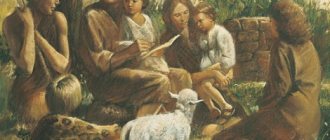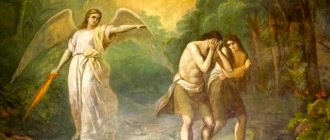According to the Bible, God began the creation of man and woman on the sixth day at the crown of his creation, saying: “Let us make man in Our image and after Our likeness” (Bible, Genesis 1.26).
The plural "We" indicates that God exists in many persons, Father, Son and Holy Spirit. Thus, man in his spiritual aspect is created in the image of the Holy Trinity. In Genesis 2 we read that while man's body is made of earth and water (the word "Adam" means "earth"), his soul is breathed into him by the very Spirit of God. Therefore, by its nature it is both material and spiritual.
Versions of Theologians
Anastasius Sinaite
Holy abbot (end of the 6th/beginning of the 7th century) Anastasius Sinaite points out that before the mention of the creation of man in the Book of Genesis, God is mentioned only in one word - “God”, while after that he has a double name - “Lord God”.
This is a subtle prophecy that God will take on a second nature when he becomes a man in Jesus Christ! Therefore, from the very beginning, God knew that for the sake of saving his greatest creation he would take on human nature, becoming, as the holy apostles Thomas said on the day of the Resurrection, “My Lord” (in his humanity) and “My God” (in his divinity) ( John 20.28).
The image of God in man has been interpreted differently by the holy fathers, but the general agreement is that it refers to what distinguishes man from animals - his free will, his rationality and his eternity.
According to the holy Christian theologian Gregory of Nyssa, man is created in the image of God because he is created in the image of the Lord Jesus Christ, the Second Person of the Holy Trinity and the God-Man. Like the artist and his model, God took the incarnate Christ as his model in the creation of man.
Basil the Great
About the creation of man and woman, St. Basil the Great (c. 330-379) writes: “We possess one creation, we acquire another by free will. In other words, we use our free will to direct our created nature, which has the ability to acquire the likeness of God, to actually possess that likeness.
The likeness of God in man is deification, holiness, the full indwelling of the Holy Spirit. Adam was holy and like God in the beginning, but he lost this holiness in the fall.
Vladimir Lossky
The modern French theologian of the Paris School, Vladimir Lossky (1903-1958), writes: “an image cannot be objectified, one might say, “naturalized”, by attributing it to one or another part of the human being.
To be in the image of God, the Fathers argue, ultimately means to be a personal being, that is, a free, responsible being. Why, one might ask, did God make man free and responsible? Precisely because he wanted to call him to a higher calling: deification, that is, to become by grace, in a movement as limitless as God, what God is by nature. And this call requires a free response; God wants this movement to be a movement of love...
Gregory of Nyssa
“A personal being is capable of loving someone more than his own nature, more than his own life. Man, that is, the image of God in man, is then the freedom of man in relation to his nature, “the fact of liberation from necessity and not subjection to the domination of nature, but the ability to freely determine oneself” (St. Gregory of Nyssa).
Creation of man
Eve also took part in Adam's Godlikeness; both the unity and the difference of the sexes are contained in the words: “in the image of God he created them; male and female” (Genesis 1.27).
But in the beginning there was only the male of the race, Adam, whose body was created from dust mixed with water, and his soul from the “breathing” of the Spirit of God (Genesis 2.7).
Some texts say that man consists of spirit, soul and body. “Spirit” is the highest part of the soul with which a person enters into prayerful communication with God. In addition, as St. Seraphim of Sarov points out, we can say that the Spirit was part of the original composition of man - before he lost it after the Fall.
A few words about the Bible
No matter how you look at the biblical text, it is important to know that for Christians it is it that sets the foundations for understanding man, family and the meaning of life. At the same time, the biblical narrative is very far from the philosophical popular science approach to which we are accustomed when discussing serious topics. The first books of the Bible were written long before the birth of Christ. At that time, many peoples did not have a developed culture or even a written language. That was the time when myth reigned on earth. I once wrote about the myth in a little more detail. As I understand it, myth is a collective and nameless tradition of understanding human life, collected in metaphors and images, presented in stories. Myth differs from philosophy and science in that it provides a holistic worldview picture in the form of a narrative. Myth removes the line between the real, physical world and the world of goals and meanings. He may not explain anything, but he always reveals the worldview itself in images. Ancient myths may not have historical truth, but they do have pedagogical and religious truth.
In ancient times, there was no other language other than mythological, no other culture of testimony about important existential issues - those that are now called philosophical or religious. For the Bible, it was important to convey to people not terminology and logic, but the experience of communication between man and the Personal and Living God. Therefore, the biblical narrative in some of its parts is very close in style and language to the mythical; The main task of these parts is to help people gain the correct worldview, to join the experience of life and the experience of communication with God of past generations. We are talking specifically about pedagogical and religious truth, and not event-historical truth. It makes no sense to talk about biblical texts in categories that humanity has long outgrown them, that how long can one propagate anti-scientific fairy tales, etc. The experience of personal relationships is notoriously difficult to express in anything other than narrative and poetic terms, which is exactly how it is done in the Bible. No one would think of reproaching the Iliad or Romeo and Juliet or The Captain's Daughter for backwardness. Each of the books talks about experience, living human experience. The Bible, in turn, speaks of the experience of the ancient Israeli people and the experience of Christ’s disciples. Perhaps in our time someone would express the biblical truths better. Don't know. But the Bible lays out everything important quite clearly and very practically.
I will add that the Bible is a polemical book, one of its main themes is the testimony of monotheism, the testimony of the One Living Personal God, by choosing whom a person loses the need for any kind of religiosity, for the God of the Bible is like a Father for people, He Himself faces person enters into communication with a person.
Creation of woman
However, judging that Adam should not be alone and needed “a helper like him” (Genesis 2.18, 20). The Lord God put the man into a deep sleep ["ecstasy" in the Greek text of the Septuagint], and while he slept, he took one of his ribs and covered its place with flesh; and the rib which the Lord God took from the man whom he had turned into a woman, and brought her to the man." The Hebrew word translated here as “deep sleep,” tardema, actually means “visionary trance,” which is close to the “ecstasy” of the Septuagint.
Modern Theologians write: “the description of a woman made from a man's rib” has led to the erroneous conclusion that women are inferior to men because they come from one small part of the male anatomy.
However, God told Moses to make four gold rings for the Ark of the Covenant: “two rings on one side of it and two rings on the other side of it.” Likewise, when God takes from a man to make a woman, Eve comes from the entire side of Adam's body, not from one rib.
“Adam’s own words make it clear that Eve comes from one side of him when he declares of his wife, “Finally, she is bone of my bone and flesh of my flesh!” (Genesis 2:23). If Eve had been created only from this man's rib, Adam could only have said that she was "bone of his bone." “Like the bone and flesh of Adam, woman is the other half of man.” “When man and woman cleave to each other and return to being “one flesh,” the two equal halves of humanity are united.
The creation of man and woman as the original couple in Genesis represents God's vision of equality and complementarity between the sexes.
The bride of Christ, from the blood and water that flowed from his side in the dream of death on the cross. “It is not without significance,” writes Saint Ambrose, “that woman was made from Adam’s rib. She was not made of the same earth as he, to show that the creation of man and woman and physical nature were identical, and that together they were one source for the propagation of the human race.
Thus, neither man was created with woman, nor two men nor two women were created in the beginning, but first man and then woman.
God desires that human nature be established as a whole. Therefore, from the very beginning of our race, he excluded the possibility of the emergence of different natures.
God created all creation to be functionally mature, not with visible signs of age.
Jonathan Sarfati
Adapted from Jonathan Sarfati's outstanding 2015 book, The Genesis Narrative: Theological, Historical, and Scientific Commentaries on Genesis 1-11.1
One of the amazing characteristics of the account of God's creation in Genesis 1 is that the created objects were fully prepared to perform their assigned functions. On the third day of creation, God created plants mature, already bearing seeds.
Later, on the fifth and sixth days, He created animals - already adults, capable of reproducing. And finally, he created Adam and Eve as adults, capable of talking and reproducing. From inanimate objects, on the fourth day God created the Sun and stars, and they were already capable of performing their function.
All this is a creation with functional maturity.
At the same time, there is one erroneous concept of “creation with visible signs of age.” One of its obvious defects is that there are no visible signs of age! Rather, we judge age based on visible features of appearance, making certain assumptions about processes that change over time, as well as about primordial conditions.2
I will try to explain this idea further by giving some examples from Scripture, as well as some erroneous, but often misunderstood ideas of Philip Gosse.
Observation object
A hypothetical modern observer who went back in time to see Adam and Eve at the end of the sixth day of creation might assume that they were adults, about 20 years old, when in fact they were less than one day old. However, they were mature adults. In addition, at the time of their creation, the blood in their arteries was already filled with oxygen to supply the cells of the body with everything they needed. Today, oxygen enters the blood from the air through the lungs.
However, one of the remarkable features that distinguished them from all their descendants must have been their lack of a navel. After all, the navel is a scar from the umbilical cord, which connected us to our mother through the placenta.
It is also a place where the abdominal muscles become thinner, resulting in potential susceptibility to hernias. Adam and Eve were created directly by God, which is why they did not have a navel.
The navel of any of them would not serve any function, but would only be evidence of something that never happened.
In the same way, the trees created on the third day were already mature, and an observer going back in time could assume that they were hundreds of years old. But if he had cut down this tree, he would have been stunned not to see growth rings on its trunk. Today, growth rings primarily reflect seasonal changes in wood growth rates, and not always annual changes.3
Likewise, God probably created the Sun with sufficient helium content. And this helium content seems to be part of the design to make the Sun hot enough. And the reasons for this are as follows.
A helium nucleus (alpha particle) takes up less space than four hydrogen nuclei (protons). This causes the core to contract, and higher temperature and pressure increase the rate of nuclear fusion, and therefore the release of energy.
Perhaps this process is responsible for the exceptional stability of the Sun.4
If we rewind the situation back to the past, the Sun, consisting only of hydrogen, would be much colder. This is called the faint young Sun paradox.
5 Evolutionists and proponents of the theory of the ancient age of the universe believe that life on Earth appeared approximately 3.8 billion years ago. But if this were really so, then it turns out that the Sun today is 25% brighter than it was then.
This means that the Earth should have been frozen with an average temperature of -3°C. However, most paleontologists believe that the Earth was warmer in the past.6
Does a “mature creation” make God a deceiver?
In no case! Since age perceptions are inferences made from assumptions, there is no cheating in people making incorrect assumptions about initial conditions.
And in fact, how could God deceive us if He told us clearly and clearly about when He did what. Rather, people who deny His word are deceiving themselves.
The charge of deception could be brought forward if the creation was created with the appearance of a false past and this was completely unnecessary for functional maturity.
This concept is clearly illustrated in the Parable of the Candle, which I highly recommend for understanding why maturity is not a lie.7
Links and notes
- Creation Book Publishers, Powder Springs, Georgia. Return to text.
- Wieland K. Earth: How old does she look? Creation 23 (1):8–13, 2000; creation.com/earth-look. Return to text.
- Batten D. Three-ring dating (dendrochronology), creation.com/tree-rings, 2001. Return to text.
- Sarfati D. Age of the Sun. creation.com/sun-age, November 13, 2011. Return to text.
- Sarfati D. Our permanent Sun: a problem for billions of years. Creation 26 (3):52–53, 2004; creation.com/faint-sun. Return to text.
- Faulkner D. The paradox of the young weak Sun and the age of the Solar System. J. Creation 15 (2):3–4, 2001. Return to text.
- Wiebe, Garth. Parable about the candle. creation.com/candle. Return to text.
- Statham, D., Darwin, Lyell and Origin of Species, creation.com/darwin-and-lyell, 5 November 2009. Return to text.
- Reed, J., St Hutton's Hagiography, J. Creation 22 (2):121–127, 2008; creation.com/hutton2. Return to text.
- Mortenson, T., The origin of old-earth geology and its ramifications for life in the 21st century, J. Creation 18 (1):22–26, 2004; creation.com/oldearth. Return to text.
- Eg philosopher Alvin Plantinga (1932– ) wrote that biblical ('young earth') creationists “often suggest that when God created the world 6,000–10,000 years ago, he created it in a 'mature state', complete with crumbling mountains, fossils, and light apparently traveling from stars millions of light years distant.” (Where The Conflict Really Lies: Science, Religion, & Naturalism, p. 10, Oxford University Press; see review by Kay, M., J. Creation 28 (2): 29–34). Of course, even a modicum of research would have shown that creationists believe that fossils are the result of rapid burial, mostly during Noah's Flood, and that today's mountains were uplifted after the Flood. Return to text.
- Zivkovic, B. (aka 'Coturnix'), Why teaching evolution is dangerous, scienceblogs.com, 25 August 2008. See also Sarfati, J., Evolutionist: it's OK to deceive students to believe evolution; creation.com/deceive, 24 September 2008. Return to text.
- Sarfati, J., (1) Why does science work at all? Creation 31 (3):12–14, 2009; creation.com/whyscience; and (2) The biblical roots of modern science, Creation 32 (4), 2010; creation.com/roots. Return to text.
- Thwaites, Ann, Glimpses of the Wonderful: The Life of Philip Henry Gosse, 1810–1888, 2002. Return to text.
Differences between men and women
And yet there are differences between men and women. These differences are for the sake of sexual reproduction - but not only for this...
Thus” Adam said: “This is now bone of my bone and flesh of my flesh; she will be called woman because she was taken out of man. Therefore a man will leave his father and his mother and cleave to his wife; and they will be in one flesh.” Thus, Adam,” writes Saint Ephraim, “was, one in that he was a man, two in that he was created male and female.” Again: “he revered [[Eve], writes St. John Chrysostom, “and made them one even before his creation.” But “the wise counsel of God at first divided the one into two; and wanting to show that even after separation it still remains one, he did not allow the continuation of the race to be possible only through one person... “So,” concludes the Holy Father, “one can see that they are one, for she was created from his sides, and they are like two halves.”
Spiritual interpretation of the sexes
A more spiritual interpretation of the differentiation of the sexes is that through it God instilled into the nature of each of us an intuitive understanding of the relationship between God and his creation, with God taking the masculine, active role of savior and protector, while man in relation to God takes on the feminine, active role of savior and protector. passive role. Many biblical passages portray God as the bridegroom of the human soul...
Modern proponents of the ideology argue that gender differences are unimportant and can therefore be “redefined,” that men can become women and women can become men. However, according to the Holy Scriptures, the difference - and attraction - between man and woman existed from the very beginning, even before the Fall. When Eve was created from the side of Adam, he said of her: “This is now bone of my bone and flesh of my flesh; and she will be called the woman [[Isha in Hebrew] because she was taken from the man [[Isha].
Adam recognizes that they are one flesh—in other words, that they are married—physically married.
These words, as Bishop Nikolai Velimirović writes, are “the basis and cause of the mysterious attraction and union between man and woman.” They “became,” writes Saint Asterius of Amasea, “a general recognition addressed on behalf of all men to all women, to the entire female sex. These words connect everything else. For what happened in the beginning in these primeval ones passed into the nature of their descendants.”
“This is the origin,” writes Archpriest Lev Lebedev, “of a man’s irresistible attraction to his “wife” (woman) as the most necessary addition to his own nature. Union in love with a woman can only be replaced by Union in love with God, which is immeasurably deeper. It is on this unity with God that monasticism is based, therefore it does not lead to psychological complexes. But monasticism is not for everyone; it is the lot of special people “who can accommodate” this state. But for the majority, a woman remains one of the most necessary conditions for normal existence.
Adam continues: the famous words that the Lord Jesus Christ, following the Apostle Paul, considered as the fundamental document of marriage: “For this reason a man will leave his father and his mother and be united to his wife; and they will be in one flesh.”
Sexual intercourse in the spiritual aspect
The Christian theologian Gregory of Nyssa (c. 335-394) argues that the entire apparatus of sexual anatomical differences and sexual reproduction, being aspects of the “garment of skins” given to Adam and Eve after their fall, arose only after the Fall.
If this is so, then sexual intercourse took place, as St. John Climacus points out, only after the fall.
But the fact remains that Adam was a man and Eve was a woman already in Paradise, before the Fall, that they were married and of one flesh already in Paradise. They had a physical attraction and were attracted to each other in a natural but sinless, infallible way.
Thus, Saint Cyril of Alexandria writes about the body of Adam before the Fall that it “was not completely free from the lust of the flesh.” For although she was beyond corruption, she did have innate appetites, appetites for food and reproduction. But the most amazing thing was that his mind was fresh. For he freely did what he wanted, seeing that his flesh was not yet subject to the passions arising from corruption.
The Fall. What does the Bible say?
I will quote the words of the Bible:
And the serpent said to the woman: Did God truly say: You shall not eat from any tree in the garden? And the woman said to the serpent: We can eat fruit from the trees, only from the fruit of the tree that is in the middle of the garden, God said, do not eat it or touch it, lest you die. And the serpent said to the woman: No, you will not die, but God knows that on the day that you eat of them, your eyes will be opened, and you will be like gods, knowing good and evil. And the woman saw that the tree was good for food, and that it was pleasant to the eyes and desirable because it gave knowledge; and she took of its fruit and ate; and she gave it also to her husband, and he ate. And the eyes of both of them were opened, and they knew that they were naked, and they sewed together fig leaves and made aprons for themselves.
And they heard the voice of the Lord God walking in the garden in the cool of the day; and Adam and his wife hid from the presence of the Lord God among the trees of paradise. And the Lord God called to Adam and said to him: Adam, where are you? He said: I heard Your voice in paradise, and I was afraid, because I was naked, and I hid myself. And God said: Who told you that you were naked? have you not eaten from the tree from which I forbade you to eat? Adam said: The wife whom You gave me, she gave me from the tree, and I ate. And the Lord God said to the woman: Why have you done this? The woman said: The serpent deceived me, and I ate.
He said to his wife: I will multiply your sorrow in your pregnancy; in illness you will give birth to children; and your desire will be for your husband, and he will rule over you.
And he said to Adam: Because you listened to the voice of your wife and ate from the tree, the ground is cursed because of you; you will eat from it in sorrow all the days of your life; She will bring forth thorns and thistles for you; and you will eat the grass of the field; By the sweat of your face you will eat bread until you return to the ground from which you were taken; for dust you are, and to dust you will return.








